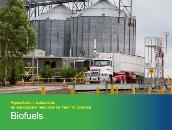 Biofuels – From Sorghum to Ethanol (video)
Biofuels – From Sorghum to Ethanol (video)
TLF ID M020826
This is a video [6:05 min] about the production of ethanol from sorghum at the Dalby Bio-Refinery in Queensland. The video describes and illustrates the stages in the production process including milling the sorghum into ‘flour’; mixing the flour with water to hydrolyse the starch; adding enzymes to liquefy the starch (the ‘mash’) and convert it to glucose; fermenting the mash with yeast to produce ethanol and carbon dioxide; distilling and dehydrating the ethanol; and drying the by-products. Throughout the video Swart interpolates statistical information such as how much ethanol is produced from a tonne of sorghum and how much energy and water the refinery uses. The video is 6:05 min long and concludes by identifying environmental and performance benefits of ethanol as a fuel.
